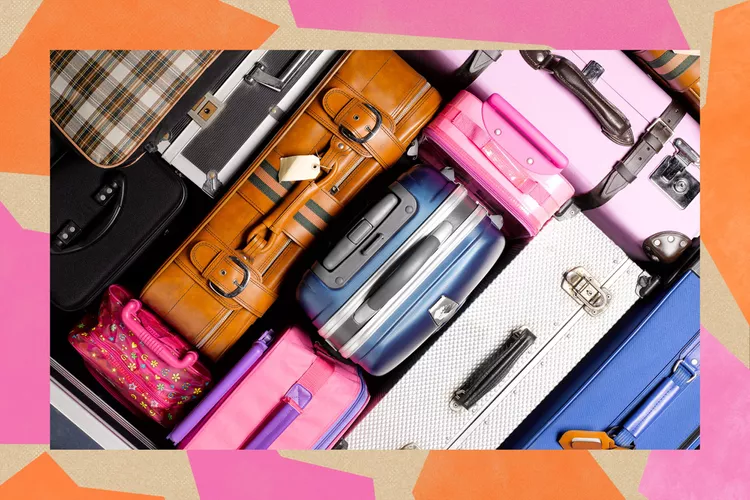As styles and travelers’ needs have changed throughout the years, so has our luggage. Here is a look back at the suitcases that made lasting statements, then and now.
From leather steamer trunks that dominated the luxury travel scene in the 19th century to today’s sleek spinner suitcases available on e-commerce platforms and through chic direct-to-consumer brands, it’s no secret that luggage has evolved dramatically over the years.
Modern updates like 360-degree spinner wheels, expandable zippers, and interior organizational pockets have made packing more manageable, traveling through airports easier, and maneuvering through city streets more accessible. Below, we’ve outlined the evolution of luggage in the U.S., covering everything from the first rolling suitcase to the market’s most popular backpacks for business travel.
19th Century: The Steamer Trunk Dominates the Luggage Industry

Long before wheeled suitcases, not to mention expandable roller bags with 360-degree spinner wheels, steamer trunks were the most common form of luggage. While they weren’t easy to maneuver, these cases, often made from leather and wood, were spacious and ideal for long journeys. They were designed to fit in the cargo hold of ships versus today’s luggage that’s meant to traverse both busy airports and cobblestone streets.
1910: Samsonite Is Founded in Denver, CO

Samsonite was founded in 1910 in Denver, CO, by Jesse Shwayder, who served as the company’s president until 1960. For years, the brand was at the forefront of design for non-wheeled suitcases; for example, it introduced the Ultralite suitcase in 1956, “the first luggage to move away from wooden box construction in favor of a revolutionary ‘jet age’ magnesium — the lightest, strongest, structural metal known at that time,” according to a representative from the brand. With other launches, like the Saturn suitcase in 1969 made from polypropylene and supported by a molded shell, and the brand’s first wheeled suitcase in 1974, Samsonite has continued to innovate over the years.
1937: Rimowa Launches the First Aluminum Trunk

Although Rimowa was founded in 1898, making hardwearing wooden travel cases, the brand changed the luggage game in 1937 with its first aluminum trunk, providing travelers a luxurious new way to transport their travel essentials in style. Today, you can discover stylish and durable aluminum rolling suitcases from the brand, keeping vintage style in mind while incorporating modern functionality.
1970: The Wheeled Suitcase Enters the Scene

The invention of the wheeled suitcase is widely credited to Bernard Sadow, who worked for U.S. Luggage. In 1970, while on a Caribbean vacation with his family, Sadow noticed an airport employee carrying luggage on a rolling cart. This observation inspired him to add wheels to his own luggage. After returning to work, he fitted a set of ball casters on a suitcase’s bottom and attached a rope as a handle. Consequently, rolling luggage was born and patented in 1972.
1975: Tumi Revolutionizes Luggage for Business Travel

Tumi entered the luggage market in 1975, focusing on bags designed specifically for international business travel. By the 1980s, Tumi became renowned for its soft ballistic nylon travel bags, similar to the staple business travel bags it produces today, including backpacks, garment bags, and soft-sided suitcases.
1987: Travelpro Makes Airline Crew-approved Luggage

After its founding in 1987 by commercial airline pilot Bob Plath, Travelpro quickly became a popular choice among flight crews. The durability and ease of maneuvering their suitcases through busy airports contributed to this preference. Frustrated with traditional luggage, Plath invented a two-wheeled suitcase pulled upright by an extendable handle — the Original Rollaboard.
2016: Away Makes Luggage Stylish Again

When Away launched in 2016, it aimed to fill a gap in the luggage market by offering a brand that combined “utility and style needs of a modern-day traveler,” according to the brand’s chief design officer, Cuan Hanley. Today, one can hardly pass through an airport without seeing Away’s sleek hardside luggage available in an array of chic colors, from muted blues to blush pinks.
2020: Paravel Launches the First Carbon Neutral Suitcase

When Indré Rockefeller and Andy Krantz founded Paravel in 2016, they aimed to create travel accessories that offer a timeless aesthetic while prioritizing sustainability. “Our goal was to reimagine the travel goods space, providing inspiration, information, and products that reflect the values of an increasingly conscious traveler,” Rockefeller stated.
Their environmentally-minded approach paid off when the brand introduced the world’s first carbon-neutral suitcase in 2020. Made from materials like recycled water bottles, vegan leather, and recycled aviation-grade aluminum, the luggage combines functionality with style. “Most importantly, we made the Aviator suitcase 100 percent carbon neutral by offsetting all the carbon emissions generated throughout its lifecycle,” Krantz added.





